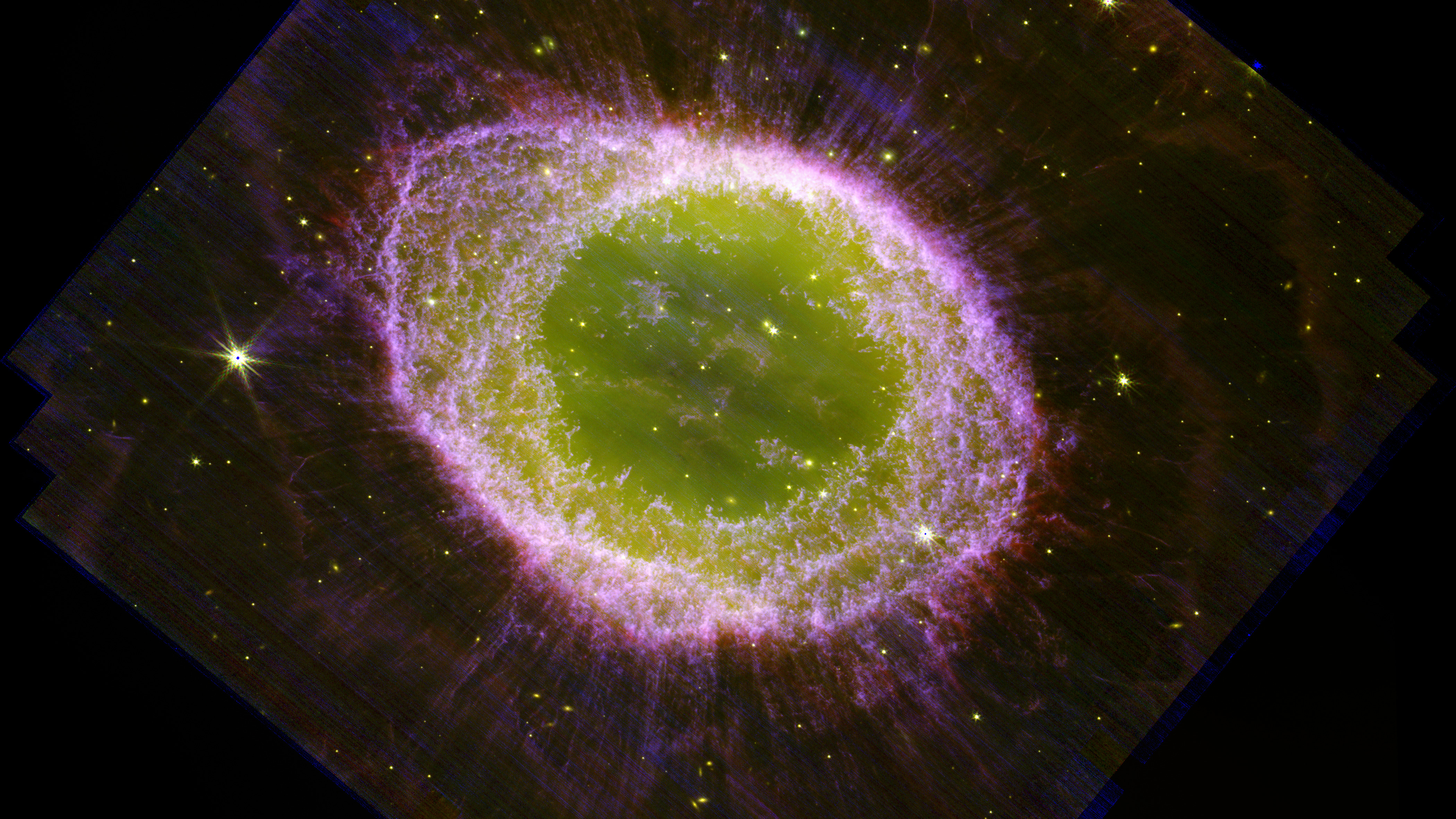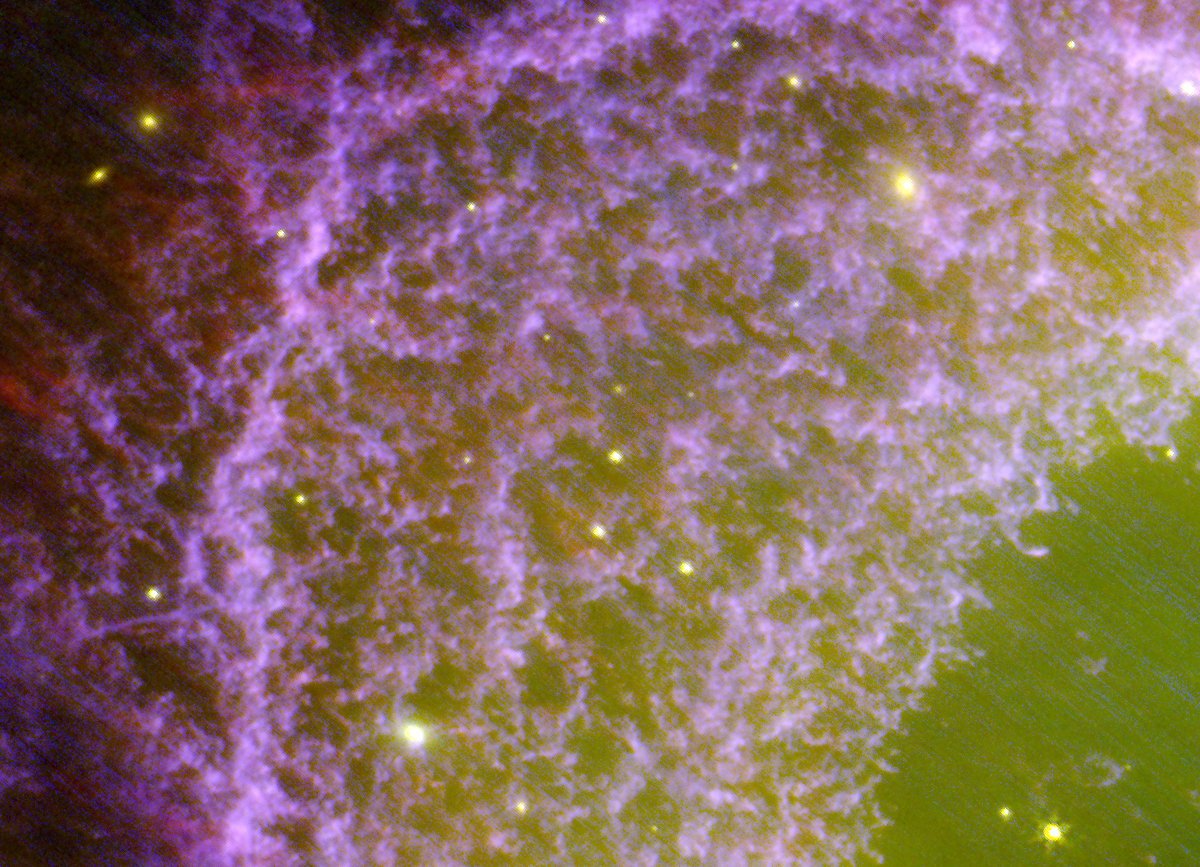James Webb Space Telescope reveals the colorful Ring Nebula in exquisite detail (photos, video)
"We are witnessing the final chapters of a star's life, a preview of the sun's distant future."
The James Webb Space Telescope has imaged the Ring Nebula as a glowing green and purple eye, presenting the familiar astronomical object in an altogether new light.
Aside from its stunning aesthetic value, the James Webb Space Telescope (JWST) images show the Ring Nebula, also known as Messier 57 (M57), located around 2,200 light-years away, in intricate detail that will surprise even astronomers who are familiar with the object.
Located in the Lyra constellation, the Ring Nebula is a popular target for space enthusiasts as its donut-shaped ring of glowing gas and dust is visible even with small backyard telescopes throughout the summer.
"I first saw the Ring Nebula as a kid through just a small telescope," Western University astrophysicist and core member of JWST Ring Nebula Imaging Project, Jan Cami, said in a statement. "I would have never thought that one day, I would be part of the team that would use the world's most powerful space telescope ever built to look at this object."
Related: James Webb Space Telescope unveils the gravitationally warped galaxies of 'El Gordo'
The Ring Nebula is the glowing remains of a long-dead star, a class of astronomical object called a "planetary nebula," which somewhat confusingly has nothing to do with planets. At its heart is a white speck that represents a white dwarf star — what remains of that extinct stellar body's core.
M57, or the Ring Nebula, is particularly fascinating to astronomers because not only is it close enough to be viewed with even amateur telescopes, but from our vantage point in the solar system, the planetary nebula is tilted so that it is viewed face-on. That means that observing the Ring Nebula with space telescopes offers astronomers the opportunity to see what is going on within planetary nebula and shed light on the life and death of stars.
Breaking space news, the latest updates on rocket launches, skywatching events and more!
"The James Webb Space Telescope has provided us with an extraordinary view of the Ring Nebula that we've never seen before," University College London professor and co-lead scientist of the JWST Ring Nebula Imaging Project, Mike Barlow, said. "The high-resolution images not only showcase the intricate details of the nebula's expanding shell but also reveal the inner region around the central white dwarf in exquisite clarity."
A sneak peak at the sun's future
When stars of similar sizes to the sun exhaust their fuel for nuclear fusion, they can no longer support themselves against the inward force of their own gravity, ending the balancing act that kept the star stable for as long as billions of years.
As the core collapses, the outer layers of the star, where nuclear fusion still proceeds, are blasted outwards. This initially causes the star to swell out as a red giant, a phase which the sun will undergo in around 5 billion years when it will puff out to around the orbit of Mars, consuming the inner planets, including Earth.
This outer shell of material eventually cools and disperses to form a variety of different shapes, including wispy clouds, expanding bubbles or ring-shaped nebulas like M57. What shape a planetary nebula will take hinges on the complex physical processes occurring within it, processes that scientists still don't fully understand.
That means that observations of this system give us a glimpse of what the solar system could look like in billions of years.
"We are witnessing the final chapters of a star's life, a preview of the sun's distant future, so to speak, and JWST's observations have opened a new window into understanding these awe-inspiring cosmic events," Barlow explained. "We can use the Ring Nebula as our laboratory to study how planetary nebulas form and evolve."
Astronomers can also glean information about the chemical processes occurring in the planetary nebula by analyzing the colors their gas and dust emit as the stars in their centers blast it with radiation.
"The structure in this object is incredible, and to think that this is all created by just one dying star," Western University astrophysicist Els Peeters said. "Beyond the morphological treasure trove, there is also much information on the chemical makeup of the gas and dust in these observations. We even found large carbonaceous molecules in this object, and we have no clear idea how they got there. Yet."
The material in planetary nebulas like M57 is enriched with the heavy elements that are forged during the life of the dead star that created it. Eventually, much of this matter will be incorporated into huge clouds of gas and dust called interstellar clouds. When dense patches of these clouds condense and collapse under their own gravity, they birth new stars that contain the material from stellar predecessors. That means objects like the Ring Nebula can weave a tale of stellar life and death.
"These images hold more than just aesthetic appeal; they provide a wealth of scientific insights into the processes of stellar evolution," co-lead scientist of the JWST Ring Nebula Imaging Project, Nick Cox, said. "By studying the Ring Nebula with JWST, we hope to gain a deeper understanding of the life cycles of stars and the elements they release into the cosmos."

Robert Lea is a science journalist in the U.K. whose articles have been published in Physics World, New Scientist, Astronomy Magazine, All About Space, Newsweek and ZME Science. He also writes about science communication for Elsevier and the European Journal of Physics. Rob holds a bachelor of science degree in physics and astronomy from the U.K.’s Open University. Follow him on Twitter @sciencef1rst.



